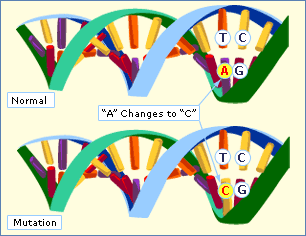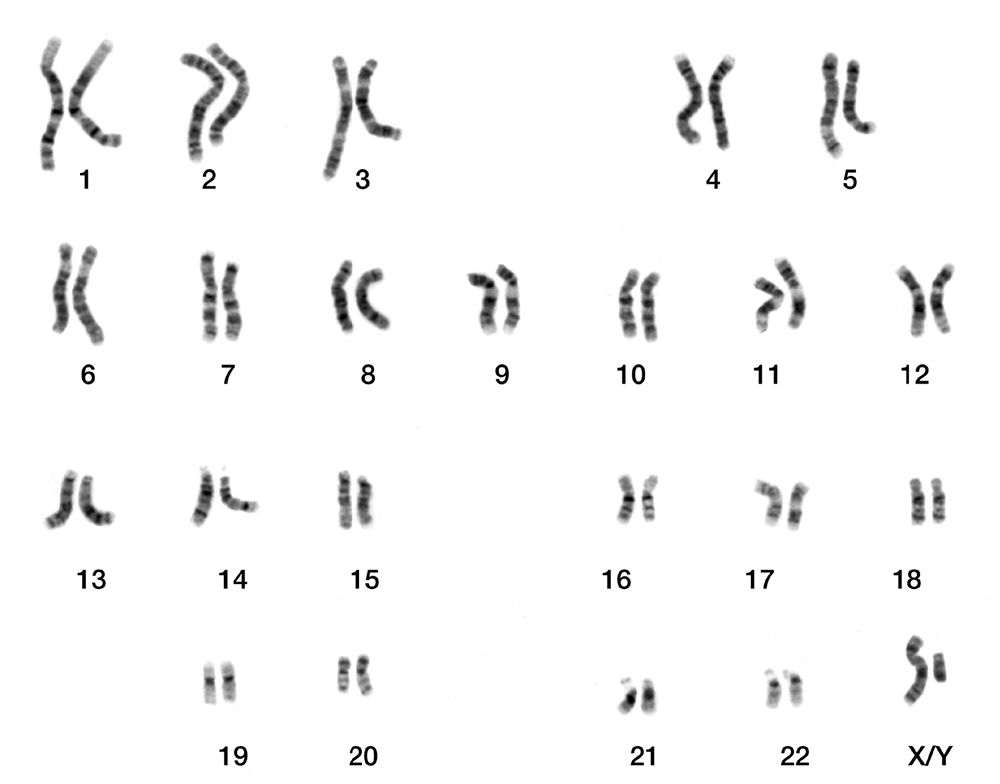
What is a genetic disorder?
Genetic disorders are illnesses caused by abnormalities in the genome. They may or may not be heritable. In non-heritable genetic disorders, the disorder may be caused by new mutations to the DNA. The disorder will only be heritable if it occurs in the germline, a series of germ cells developed from earlier cells. The disorder can be hereditary, caused by a mutation, or mainly by environmental causes.
Four types of genetic disorders are single gene disorders, multifactorial disorders, chromosomal disorders, and mitochondrial disorders.

Genetic mutations occur when there is a deletion, insertion, or rearrangement of genes or chromosomes. They are permanent changes in the sequence of a person's DNA. Most DNA changes fall in the large areas of the genome that sit between genes. DNA has a specific pattern of amino acids that pair up (adenine and thymine; guanine and cytosine) and if one amino acid is misplaced, the change compromises the protein's function. Even one change of amino acid sequence can alter a wide range of functions in the cell from the movement of materials going in and out to synthesizing proteins. Mutations can also generate new variations that sometimes can give an individual a survival advantage.
Mutations create a different form of a gene, usually causing hereditary variation, called alleles. These small differences in DNA sequence account for the variation in human hair and skin color, height, body build, behavior, and susceptibility to disease - helping popuations change over time.
Mutations can either be hereditary or acquired. Hereditary mutations, also known as germline mutations, are passed down from parent to offspring and are found in the reproductive cells of an organism. Acquired mutations, or somatic mutations, are not hereditary and can occur in any of the cells of the body except the germ cells (sperm and egg); therefore not able to be passed on to offspring. These mutations are changes in the genome that accumulate over one's lifetime, such as errors in cell division or evironmental factors. They take place after conception in cells that will not become eggs or sperms. The changes are passed down only to the cells that originate from a cell with the mutation. Somatic mutations can cause cancer and other diseases.
What is a mutation?
Single gene disorders (also known as Mendelian or monogenic disorders) are the result of a single mutated gene. These can be passed on to generations in several ways. Single gene disorders are caused by alterations that occur in the DNA sequence of a single gene.
More than 6,000 human diseases are caused by single gene disorders. Single gene disorders are individually rare but occur in about 1.4% of the population as a whole, causing a high rate of disease and mortality.
These diseases are inherited in recognizable patterns and are classified according to how they are transmitted from one generation to the next. If the mutation is on an autosome, the condition is said to be inherited in an autosomal pattern. If the alteration is on the X chromosome, the condition is said to be inherited in an X-linked manner. Autosomal dominant, autosomal recessive and X-linked recessive conditions are the most common. X-linked dominant conditions also occur, but are rare.
What is a single gene disorder?
Unlike gene mutations that change a single gene, chromosome mutations change and impact the entire chromosome, resulting in changes in the number of chromosomes in a cell or changes in the structure of a chromosome.These are normally unpredictable changes. These changes are most often due to problems that occur during meiosis (the cell division process of gametes) or by mutagens (radiation).
Chromosome abnormalities are usually a result of nondisjunction (the failure of chromosomes to separate properly during meiosis) during sperm or egg formation.
Altered chromosome structure is due to duplications and breakages of chromosomes that are responsible for chromosome mutation. By changing the genes on the chromosome, these changes affect protein production. Chromosome structure changes are harmful to an individual; leading to developmental difficulties and possibly death. Some changes are not as harmful and may have no significant effect on an individual.
There are several types of chromosome structure changes that can occur:
-
translocation - the joining of a fragmented chromosome to a non-homologous chromosome
-
deletion - results from the breakage of a chromosome and the genetic material becomes lost during cell division
-
duplication - when extra copies of genes are generated on a chromosome
-
inversion - the broken chromosome segment is reversed and inserted back into the chromosome
-
isochromesome - produced by the improper division of the centromere
What is a chromosomal disorder?
Mitochondrial disorders are caused by mutations in mitochondrial DNA. Mitochondria are cell organelles responsible for converting food into energy through the process of cellular respiration. Mitochondria are essential to all higher organisms for sustaining life and slight problems with any one of the enzymes used by the mitochondria can be devastating to the cell, and organism. Mutations cause a large deletion in mitochondrial DNA. As a result of this deletion, genes that code for some essential proteins involved in oxidative phosphorylation are lost and energy production is lowered, leading to the weakness of whatever is affected.
In adults, many diseases of aging have been found to have defects of mitochondrial function, such as Alzheimer's disease, stroke, type 2 diabetes, cancer, etc.
What is a mitochondrial disorder?
Complex disorders, also known as multifactorial disorders, are caused by many contributing factors, such as genetic mutations and environmental factors. They are likely associated with the effects of multiple genes. Although they often cluster in families, these disorders have more ambiguous patterns of inheritance, making it difficult to determine a person's risk of inheriting or passing it on. Multifactorial traits do recur in families since they are partly caused by genes. The chance for a complex trait or condition to happen again depends on how closely the family member with the trait is related to another family member.These are also difficult to study and treat because complex disorders can share symptoms with other diseases. Along with that, specific factors that cause most of these disorders have not yet been identified.
Complex disorders do not always develop despite the suggested presence of a faulty gene(s), which make the person at an increased risk for developing the condition. Unless other factors are present, the condition may never develop at all.




